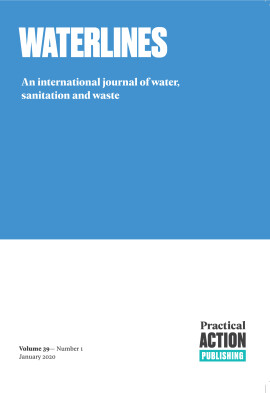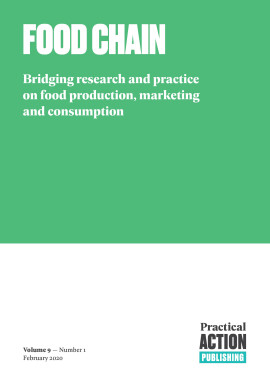Changes in extreme poverty in Bangladesh (2000–2015): trend, dynamics, and implications for research and interventions
Headcount extreme poverty in Bangladesh has been declining since 2000, but how has the profile and income distribution of the poorest changed and what do these mean for intervention design and directions for innovations? Using national and BRAC datasets, we find important changes among the extreme poor over time including their income distribution, which has become more dispersed with a stronger positive skew. The overall economic progress seems to be lifting all boats. However, most of the extreme poor remain trapped in chronic poverty. Long-term escape out of extreme poverty, even for well-designed and well-executed programmes such as BRAC’s Targeting the Ultra Poor (TUP) programme, remains modest, though the overall impact is extremely positive. We suggest a few directions for future design to accelerate progress. This will require a bolder knowledge partnership between researchers working on rigorous evidence using experimental methods and behavioural insights, and practitioners.Asadullah, M.N. and Ara, J. (2016) ‘Evaluating the long run impact of an innovative anti-poverty programme: evidence using household panel data’, Applied Economics 48(2): 107–20 <https://doi.org/10.1080/00036846.2015.1073846>.
Bandiera, O., Burgess, R., Das, N.C., Gulesci, S., Rasul, I., Shams, R. and Sulaiman, M. (2011) Asset Transfer Programme for the Ultra Poor: A Randomized Control Trial Evaluation [online], CFPR Working Paper no. 22, Dhaka: Research and Evaluation Division BRAC <https://docs.google.com/viewerng/viewer?url=http://research.brac.net/new/cfpr-tup/download/386_2970400399f5c30c0f4928db4c4becc4&a=gt> [accessed 13 February 2018].
Bandiera, O., Burgess, R., Das, N.C., Gulesci, S., Rasul, I. and Sulaiman, M. (2017) ‘Labor markets and poverty in village economies’, The Quarterly Journal of Economics 132(2): 811–70 <https://doi.org/10.1093/qje/qjx003>.
Banerjee, A., Duflo, E., Goldberg, N., Karlan, D., Osei, R., Parienté, W., Shapiro, J., Thuysbaert, B. and Udry, C. (2015) ‘A multifaceted program causes lasting progress for the very poor: evidence from six countries’, Science 348(6236) <http://dx.doi.org/10.1126/science.1260799>.
BBS (2007) Report on the Household Income and Expenditure Survey 2005, Dhaka: Bangladesh Bureau of Statistics, Planning division, Ministry of Planning, Government of Bangladesh.
BBS (2011) Report of the Household Income and Expenditure Survey 2010 [online], Dhaka: Bangladesh Bureau of Statistics, Planning division, Ministry of Planning, Government of Bangladesh <http://203.112.218.65:8008/WebTestApplication/userfiles/Image/LatestReports/HIES-10.pdf> [accessed 12 February 2018].
BRAC (2016) ‘Replication’, Ultra Poor Programme [online], <www.brac.net/targeting-ultra-poor/item/751-replication> [accessed 13 February 2018].
CFPR/TUP Research Team (2004) Stories of Targeting: Process Documentation of Selecting the Ultra Poor for CFPR/TUP Programme [online], CFPR Working Paper no. 1, Dhaka and Ottawa: Research and Evaluation Division BRAC and Aga Khan Foundation Canada <https://docs.google.com/viewerng/viewer?url=http://research.brac.net/new/publications/download/104_5a7aeaadacc2c14349a050379de2e2c1&a=gt> [accessed 11 February 2018].
Matin, I. and Halder, S. (2004) Combining Methodologies for Better Targeting of the Extreme Poor [online], CFPR Working Paper no. 2, Dhaka and Ottawa: Research and Evaluation Division BRAC and Aga Khan Foundation Canada <https://docs.google.com/viewerng/viewer?url=http://research.brac.net/new/cfpr-tup/download/82_be77538d897336be557a67d0944abb98&a=gt> [accessed 13 February 2018].
Shepherd, A., Scott, L., Mariotti, C., Kessy, F., Gaiha, R., Corta, L., Hanifnia, K., Kaicker, N., Lenhardt, A., Lwanga-Ntale, C., Sen, B., Sijapati, B., Strawson, T., Thapa, G., Underhill, H. and Wild, L. (2014) The Chronic Poverty Report 2014–15: The Road to Zero Extreme Poverty [online], Brazil: Overseas Development Institute <www.odi.org/sites/odi.org.uk/files/odi-assets/publications-opinion-files/8834.pdf> [accessed 11 February 2018].
Sulaiman, M. and Matin, I. (2006) Targeting Effectiveness of CFPR/TUP in a Scale-up Environment [online], CFPR Working Paper no. 8, Dhaka and Ottawa: Research and Evaluation Division BRAC and Aga Khan Foundation Canada <https://docs.google.com/viewerng/viewer?url=http://research.brac.net/new/cfpr-tup/download/100_bb1a60cc5f7f267eda541325952ddc14&a=gt> [accessed 15 February 2018].
Asadullah, M.N. and Ara, J. (2016) ‘Evaluating the long run impact of an innovative anti-poverty programme: evidence using household panel data’, Applied Economics 48(2): 107–20 <https://doi.org/10.1080/00036846.2015.1073846>.
Bandiera, O., Burgess, R., Das, N.C., Gulesci, S., Rasul, I., Shams, R. and Sulaiman, M. (2011) Asset Transfer Programme for the Ultra Poor: A Randomized Control Trial Evaluation [online], CFPR Working Paper no. 22, Dhaka: Research and Evaluation Division BRAC <https://docs.google.com/viewerng/viewer?url=http://research.brac.net/new/cfpr-tup/download/386_2970400399f5c30c0f4928db4c4becc4&a=gt> [accessed 13 February 2018].
Bandiera, O., Burgess, R., Das, N.C., Gulesci, S., Rasul, I. and Sulaiman, M. (2017) ‘Labor markets and poverty in village economies’, The Quarterly Journal of Economics 132(2): 811–70 <https://doi.org/10.1093/qje/qjx003>.
Banerjee, A., Duflo, E., Goldberg, N., Karlan, D., Osei, R., Parienté, W., Shapiro, J., Thuysbaert, B. and Udry, C. (2015) ‘A multifaceted program causes lasting progress for the very poor: evidence from six countries’, Science 348(6236) <http://dx.doi.org/10.1126/science.1260799>.
BBS (2007) Report on the Household Income and Expenditure Survey 2005, Dhaka: Bangladesh Bureau of Statistics, Planning division, Ministry of Planning, Government of Bangladesh.
BBS (2011) Report of the Household Income and Expenditure Survey 2010 [online], Dhaka: Bangladesh Bureau of Statistics, Planning division, Ministry of Planning, Government of Bangladesh <http://203.112.218.65:8008/WebTestApplication/userfiles/Image/LatestReports/HIES-10.pdf> [accessed 12 February 2018].
BRAC (2016) ‘Replication’, Ultra Poor Programme [online], <www.brac.net/targeting-ultra-poor/item/751-replication> [accessed 13 February 2018].
CFPR/TUP Research Team (2004) Stories of Targeting: Process Documentation of Selecting the Ultra Poor for CFPR/TUP Programme [online], CFPR Working Paper no. 1, Dhaka and Ottawa: Research and Evaluation Division BRAC and Aga Khan Foundation Canada <https://docs.google.com/viewerng/viewer?url=http://research.brac.net/new/publications/download/104_5a7aeaadacc2c14349a050379de2e2c1&a=gt> [accessed 11 February 2018].
Matin, I. and Halder, S. (2004) Combining Methodologies for Better Targeting of the Extreme Poor [online], CFPR Working Paper no. 2, Dhaka and Ottawa: Research and Evaluation Division BRAC and Aga Khan Foundation Canada <https://docs.google.com/viewerng/viewer?url=http://research.brac.net/new/cfpr-tup/download/82_be77538d897336be557a67d0944abb98&a=gt> [accessed 13 February 2018].
Shepherd, A., Scott, L., Mariotti, C., Kessy, F., Gaiha, R., Corta, L., Hanifnia, K., Kaicker, N., Lenhardt, A., Lwanga-Ntale, C., Sen, B., Sijapati, B., Strawson, T., Thapa, G., Underhill, H. and Wild, L. (2014) The Chronic Poverty Report 2014–15: The Road to Zero Extreme Poverty [online], Brazil: Overseas Development Institute <www.odi.org/sites/odi.org.uk/files/odi-assets/publications-opinion-files/8834.pdf> [accessed 11 February 2018].
Sulaiman, M. and Matin, I. (2006) Targeting Effectiveness of CFPR/TUP in a Scale-up Environment [online], CFPR Working Paper no. 8, Dhaka and Ottawa: Research and Evaluation Division BRAC and Aga Khan Foundation Canada <https://docs.google.com/viewerng/viewer?url=http://research.brac.net/new/cfpr-tup/download/100_bb1a60cc5f7f267eda541325952ddc14&a=gt> [accessed 15 February 2018].
Asadullah, M.N. and Ara, J. (2016) ‘Evaluating the long run impact of an innovative anti-poverty programme: evidence using household panel data’, Applied Economics 48(2): 107–20 <https://doi.org/10.1080/00036846.2015.1073846>.
Bandiera, O., Burgess, R., Das, N.C., Gulesci, S., Rasul, I., Shams, R. and Sulaiman, M. (2011) Asset Transfer Programme for the Ultra Poor: A Randomized Control Trial Evaluation [online], CFPR Working Paper no. 22, Dhaka: Research and Evaluation Division BRAC <https://docs.google.com/viewerng/viewer?url=http://research.brac.net/new/cfpr-tup/download/386_2970400399f5c30c0f4928db4c4becc4&a=gt> [accessed 13 February 2018].
Bandiera, O., Burgess, R., Das, N.C., Gulesci, S., Rasul, I. and Sulaiman, M. (2017) ‘Labor markets and poverty in village economies’, The Quarterly Journal of Economics 132(2): 811–70 <https://doi.org/10.1093/qje/qjx003>.
Banerjee, A., Duflo, E., Goldberg, N., Karlan, D., Osei, R., Parienté, W., Shapiro, J., Thuysbaert, B. and Udry, C. (2015) ‘A multifaceted program causes lasting progress for the very poor: evidence from six countries’, Science 348(6236) <http://dx.doi.org/10.1126/science.1260799>.
BBS (2007) Report on the Household Income and Expenditure Survey 2005, Dhaka: Bangladesh Bureau of Statistics, Planning division, Ministry of Planning, Government of Bangladesh.
BBS (2011) Report of the Household Income and Expenditure Survey 2010 [online], Dhaka: Bangladesh Bureau of Statistics, Planning division, Ministry of Planning, Government of Bangladesh <http://203.112.218.65:8008/WebTestApplication/userfiles/Image/LatestReports/HIES-10.pdf> [accessed 12 February 2018].
BRAC (2016) ‘Replication’, Ultra Poor Programme [online], <www.brac.net/targeting-ultra-poor/item/751-replication> [accessed 13 February 2018].
CFPR/TUP Research Team (2004) Stories of Targeting: Process Documentation of Selecting the Ultra Poor for CFPR/TUP Programme [online], CFPR Working Paper no. 1, Dhaka and Ottawa: Research and Evaluation Division BRAC and Aga Khan Foundation Canada <https://docs.google.com/viewerng/viewer?url=http://research.brac.net/new/publications/download/104_5a7aeaadacc2c14349a050379de2e2c1&a=gt> [accessed 11 February 2018].
Matin, I. and Halder, S. (2004) Combining Methodologies for Better Targeting of the Extreme Poor [online], CFPR Working Paper no. 2, Dhaka and Ottawa: Research and Evaluation Division BRAC and Aga Khan Foundation Canada <https://docs.google.com/viewerng/viewer?url=http://research.brac.net/new/cfpr-tup/download/82_be77538d897336be557a67d0944abb98&a=gt> [accessed 13 February 2018].
Shepherd, A., Scott, L., Mariotti, C., Kessy, F., Gaiha, R., Corta, L., Hanifnia, K., Kaicker, N., Lenhardt, A., Lwanga-Ntale, C., Sen, B., Sijapati, B., Strawson, T., Thapa, G., Underhill, H. and Wild, L. (2014) The Chronic Poverty Report 2014–15: The Road to Zero Extreme Poverty [online], Brazil: Overseas Development Institute <www.odi.org/sites/odi.org.uk/files/odi-assets/publications-opinion-files/8834.pdf> [accessed 11 February 2018].
Sulaiman, M. and Matin, I. (2006) Targeting Effectiveness of CFPR/TUP in a Scale-up Environment [online], CFPR Working Paper no. 8, Dhaka and Ottawa: Research and Evaluation Division BRAC and Aga Khan Foundation Canada <https://docs.google.com/viewerng/viewer?url=http://research.brac.net/new/cfpr-tup/download/100_bb1a60cc5f7f267eda541325952ddc14&a=gt> [accessed 15 February 2018].
Asadullah, M.N. and Ara, J. (2016) ‘Evaluating the long run impact of an innovative anti-poverty programme: evidence using household panel data’, Applied Economics 48(2): 107–20 <https://doi.org/10.1080/00036846.2015.1073846>.
Bandiera, O., Burgess, R., Das, N.C., Gulesci, S., Rasul, I., Shams, R. and Sulaiman, M. (2011) Asset Transfer Programme for the Ultra Poor: A Randomized Control Trial Evaluation [online], CFPR Working Paper no. 22, Dhaka: Research and Evaluation Division BRAC <https://docs.google.com/viewerng/viewer?url=http://research.brac.net/new/cfpr-tup/download/386_2970400399f5c30c0f4928db4c4becc4&a=gt> [accessed 13 February 2018].
Bandiera, O., Burgess, R., Das, N.C., Gulesci, S., Rasul, I. and Sulaiman, M. (2017) ‘Labor markets and poverty in village economies’, The Quarterly Journal of Economics 132(2): 811–70 <https://doi.org/10.1093/qje/qjx003>.
Banerjee, A., Duflo, E., Goldberg, N., Karlan, D., Osei, R., Parienté, W., Shapiro, J., Thuysbaert, B. and Udry, C. (2015) ‘A multifaceted program causes lasting progress for the very poor: evidence from six countries’, Science 348(6236) <http://dx.doi.org/10.1126/science.1260799>.
BBS (2007) Report on the Household Income and Expenditure Survey 2005, Dhaka: Bangladesh Bureau of Statistics, Planning division, Ministry of Planning, Government of Bangladesh.
BBS (2011) Report of the Household Income and Expenditure Survey 2010 [online], Dhaka: Bangladesh Bureau of Statistics, Planning division, Ministry of Planning, Government of Bangladesh <http://203.112.218.65:8008/WebTestApplication/userfiles/Image/LatestReports/HIES-10.pdf> [accessed 12 February 2018].
BRAC (2016) ‘Replication’, Ultra Poor Programme [online], <www.brac.net/targeting-ultra-poor/item/751-replication> [accessed 13 February 2018].
CFPR/TUP Research Team (2004) Stories of Targeting: Process Documentation of Selecting the Ultra Poor for CFPR/TUP Programme [online], CFPR Working Paper no. 1, Dhaka and Ottawa: Research and Evaluation Division BRAC and Aga Khan Foundation Canada <https://docs.google.com/viewerng/viewer?url=http://research.brac.net/new/publications/download/104_5a7aeaadacc2c14349a050379de2e2c1&a=gt> [accessed 11 February 2018].
Matin, I. and Halder, S. (2004) Combining Methodologies for Better Targeting of the Extreme Poor [online], CFPR Working Paper no. 2, Dhaka and Ottawa: Research and Evaluation Division BRAC and Aga Khan Foundation Canada <https://docs.google.com/viewerng/viewer?url=http://research.brac.net/new/cfpr-tup/download/82_be77538d897336be557a67d0944abb98&a=gt> [accessed 13 February 2018].
Shepherd, A., Scott, L., Mariotti, C., Kessy, F., Gaiha, R., Corta, L., Hanifnia, K., Kaicker, N., Lenhardt, A., Lwanga-Ntale, C., Sen, B., Sijapati, B., Strawson, T., Thapa, G., Underhill, H. and Wild, L. (2014) The Chronic Poverty Report 2014–15: The Road to Zero Extreme Poverty [online], Brazil: Overseas Development Institute <www.odi.org/sites/odi.org.uk/files/odi-assets/publications-opinion-files/8834.pdf> [accessed 11 February 2018].
Sulaiman, M. and Matin, I. (2006) Targeting Effectiveness of CFPR/TUP in a Scale-up Environment [online], CFPR Working Paper no. 8, Dhaka and Ottawa: Research and Evaluation Division BRAC and Aga Khan Foundation Canada <https://docs.google.com/viewerng/viewer?url=http://research.brac.net/new/cfpr-tup/download/100_bb1a60cc5f7f267eda541325952ddc14&a=gt> [accessed 15 February 2018].
Community groups as an enabler for access to livelihood capitals, deprivation of which contributes to multidimensional poverty in rural Uganda
Arinaitwe, Charlotte
World Development Perspectives, Vol. 34 (2024), Iss. P.100582
https://doi.org/10.1016/j.wdp.2024.100582 [Citations: 3]- Value chain financing: evidence from Zambia on smallholder access to finance for mechanization
- Boosting financial inclusion through social assistance reform: evidence-based approach in selecting a payment system
- Developing agro-pastoral entrepreneurship: bundling blended finance and technology
- Building frontline market facilitators' capacity: the case of the ‘Integrating Very Poor Producers into Value Chains Field Guide’
- Impact of COVID-19 on livestock exports from Somalia and the Horn of Africa


